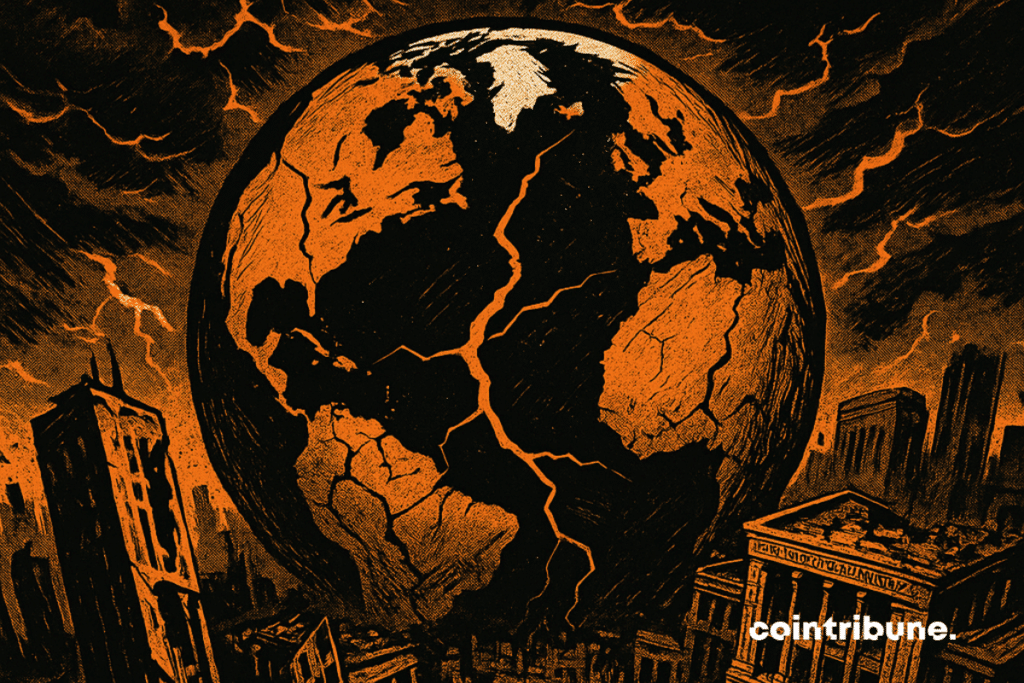The Global Economy Is Crumbling Before Our Eyes
The current global chaos is not a matter of chance. According to historians Neil Howe and William Strauss, we are entering a destructive cycle that reshapes societies every 80 to 100 years. This major transformation could upheave the global economy, financial markets, and redefine the geopolitical order as we know it. In this coming collapse, Bitcoin could very well be the escape route to save one’s savings.

In Brief
- The “Fourth Turning” theory predicts historical cycles of 80–100 years, each ending in a major crisis.
- Economic imbalances accumulated since 2008 are setting the stage for a systemic collapse.
- Geopolitical tensions between the U.S. and China risk triggering a major conflict.
A historical theory that predicts collapse
The trade war triggered by Trump, the debt crisis, and the growing tensions between the United States and the Russia-China bloc are all signs announcing a crisis of the capitalist model.
In 1997, Neil Howe and William Strauss revolutionized historical analysis with their book “The Fourth Turning: An American Prophecy.” Their bold theory proposes that History evolves according to predictable four-phase cycles, each lasting about twenty years.

These four seasons follow each other invariably. First the “High,” a period of prosperity and social cohesion, like the Thirty Glorious Years. Then the “Awakening,” a phase of questioning institutions by younger generations, as in the 1960s-70s. Next the “Unraveling,” marked by growing individualism and institutional weakening since the 1980s.
Finally comes the “Fourth Turning,” a period of deep crisis where old systems collapse. Historical examples include the American Revolution, the Civil War, and the Great Depression leading to World War II.
According to Howe, we entered this critical phase between the mid-2000s and the early 2020s.
Catalysts of the current collapse
Several converging factors explain why this Fourth Turning is happening today. The first concerns the economic imbalances accumulated over decades.
After the 2008 crisis, governments, companies, and individuals took advantage of historically low interest rates to borrow massively. This artificial monetary expansion inflated asset prices while creating a dangerous dependence on cheap credit. Today, global debt reaches unprecedented levels, pushing countries and economies to their limits.
Meanwhile, political and social fragmentation intensifies. Trust in governments, financial institutions, and media continuously erodes. Wealth inequalities widen, fueling polarization and the rise of populist movements worldwide, from Trump in the US to Meloni in Italy.
The Chinese geopolitical challenge is the third major catalyst. Beijing’s rise since the 1990s challenges American dominance, creating commercial, technological, and military tensions reminiscent of rivalries in previous Fourth Turnings. This superpower competition invariably destabilizes the established world order.
Economic scenarios for the coming years
Facing these systemic pressures, the economic consequences could be dramatic. When debts reach unsustainable levels, governments have three main options: drastically cut spending, default, or create inflation to reduce the real debt burden.
Inflation remains historically the preferred political solution, as it discreetly reduces debt without unpopular budget cuts. However, this approach devastates ordinary citizens by eroding their savings and purchasing power. The pandemic previewed this reality, with governments massively creating money, triggering a surge in essential goods prices.
If inflation spirals out of control, authorities typically resort to authoritarian measures such as financial repression, forcing investors and citizens to hold government assets despite their rapid devaluation.
Geopolitical risks amplify these economic dangers. A conflict in the Taiwan Strait could quickly escalate between the US and China, breaking global supply chains and causing widespread panic in financial markets. This geopolitical polarization already forces nations to choose sides, especially between the West and BRICS countries.
Bitcoin and actions to survive the collapse
This structural transformation demands a radically different investment approach. Financial expert Russell Napier predicts a prolonged era of financial repression, high inflation, and capital controls.
Traditional bonds, once safe havens, become dangerous. Faced with rising inflation, bondholders will demand higher yields, causing existing prices to fall. Holding government or corporate bonds during this Fourth Turning could severely compromise your portfolio.
Regarding stocks, the new economic landscape favors tangible sectors: infrastructure, defense, raw materials, manufacturing, and energy. Governments will increase spending in these areas to rebuild economies, restore supply chains, and strengthen national security.
Raw materials offer particular protection. Gold and silver historically perform well during inflation and monetary devaluation periods. Gold could even become a new reserve asset if confidence in traditional currencies falters, explaining its recent sustained rally.
For cryptocurrencies, only those with real adoption will likely survive the next bear market. Aside from Bitcoin and Ethereum, most cryptos will fall.
The decade 2020-2030 heralds a tumultuous period. Wise investors must start repositioning their portfolios now towards tangible sectors, diversify geographically, and prioritize preserving their wealth, particularly by acquiring Bitcoin. Although the near future looks chaotic, History teaches us that these crisis periods invariably lead to renewed eras of peace and prosperity.
Maximize your Cointribune experience with our "Read to Earn" program! For every article you read, earn points and access exclusive rewards. Sign up now and start earning benefits.

Chaque jour, j’essaie d’enrichir mes connaissances sur cette révolution qui permettra à l’humanité d’avancer dans sa conquête de liberté.
The views, thoughts, and opinions expressed in this article belong solely to the author, and should not be taken as investment advice. Do your own research before taking any investment decisions.